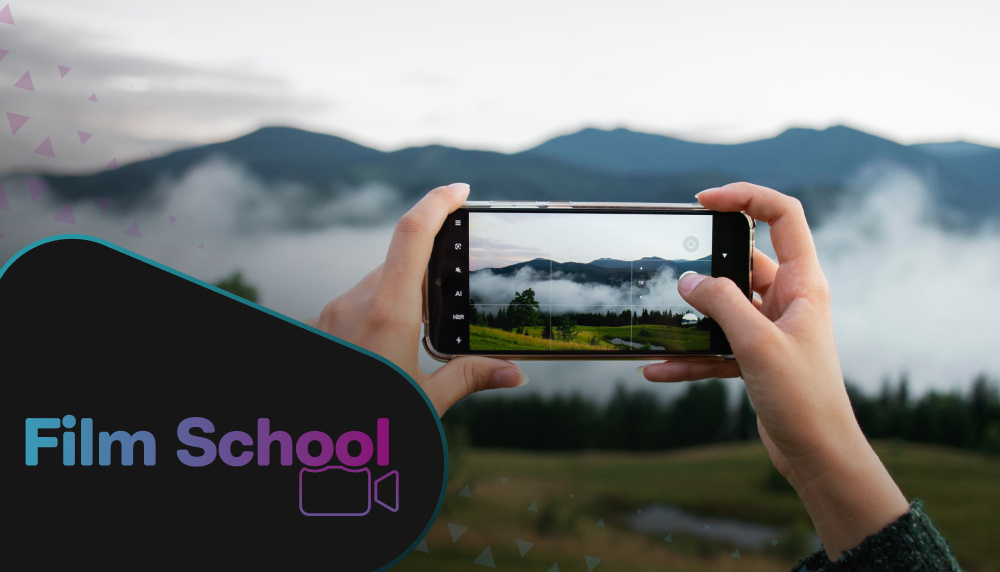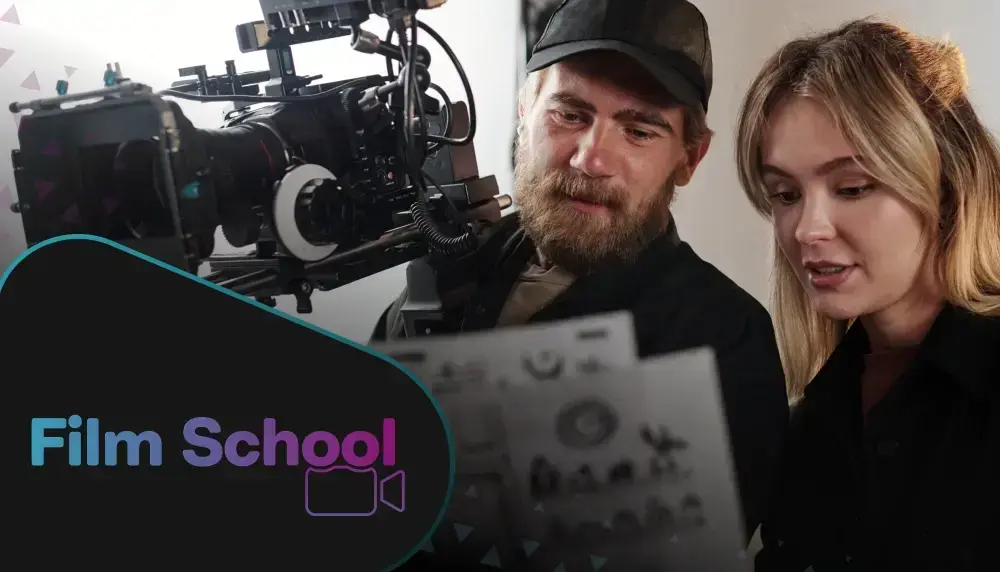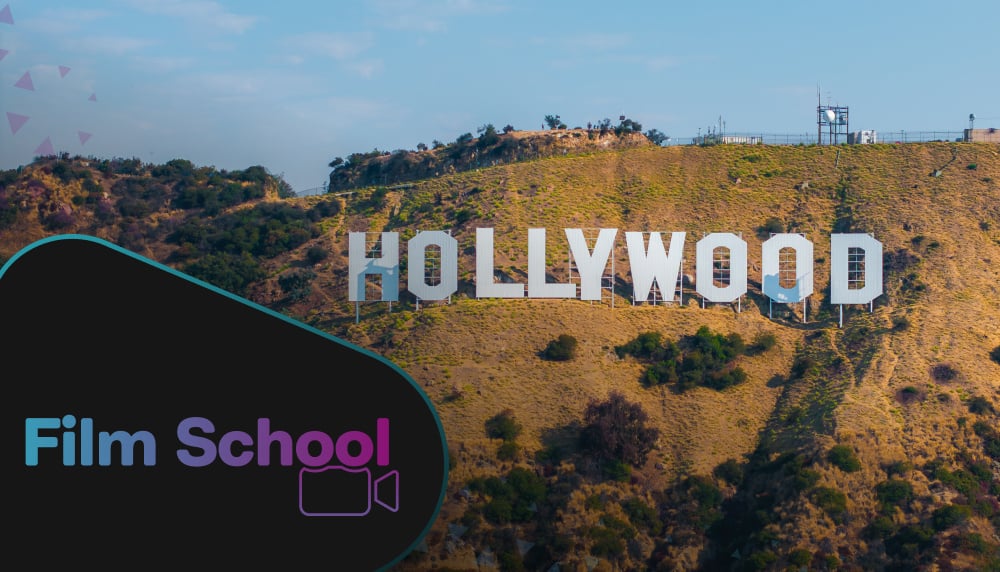
One key difference between film and television and other forms of visual art, like paintings or photographs, is the ability to directly control the viewer's focus.
While photographers and painters can use compositional techniques, such as visual guidelines created by shapes within the frame and lighting, to guide the viewer's eye, film and television have an additional tool: editing. Cutting between shots allows filmmakers to control a scene's timing, pacing, and flow and, more importantly, direct the audience's attention while shaping the overall emotional impact.
However, what if you wanted to achieve a similar result without editing? Enter: the dolly. It’s a sought-after tool by all low-budget filmmakers alike, as it has revolutionized how we can tell stories on screen.
.webp?width=600&height=450&name=image8%20(2).webp)
Image via Unsplash.
What is a dolly?
A dolly is one of Hollywood's oldest tools. At its core, it's a wheeled platform that runs along a set of tracks, allowing the camera to move smoothly and precisely.
The camera is attached to the leveling head, allowing the operator to pan and tilt while the dolly is being moved.
Dolly shots are crucial for advanced storytelling techniques. They guide the viewer's focus, build tension, and can expand the sense of scale of an object or environment. The movement can vary from gentle, subtle push-ins to fast, dramatic movement.
One of the most fundamental concepts of a dolly is that it can shift from one angle to another without a single edit. If we start on a wide angle and push toward a stationary character, we end up with a close-up. Sometimes, this uninterrupted shot can evoke greater emotion than if we were to edit from a wide shot to a close-up.
.webp?width=600&height=400&name=image6%20(3).webp)
Image via Unsplash.
Essential dolly movements and terms
When using the dolly, considering it is on a track, you can only move it in a limited number of ways. As such, there is also specific terminology tied to the movement.
- In/Out: When moving a dolly toward or away from the subject, you have two options: track forward/push in or backward/pull out. It's not a punch-in, which would be to zoom into a shot.
- Dolly Left/Right: Shifting the dolly left or right depends on its setup. On tracks, it’s a move along the axis of the track. The term here would be track right or left.
- Boom Up/Down: Most dollies come equipped with a boom—a hydraulic arm that moves vertically in a smooth, camera-ready motion. Standard boom terms include “top floor” for the highest point and “bottom floor” for the lowest. When moving a boom arm up or down, the terminology would be boom up or down.
It's essential not to confuse these terms with pan or tilt, as many new filmmakers do — they are completely different camera movements and can confuse your other crew members.
Now that we know the technical terms for movement let’s review how a dolly should be moved with motivation.
Ensure movement is motivated
While discussing camera movement on a live panel, esteemed director Guillermo del Toro said:
“I’ve had a lot of good teachers — those guys. As you say, a push-in is like underlining, while other moves, like a crane, are caps (capital letters). You need to balance the rhythm of the text. If you underline everything, nothing matters.”
While it’s tempting to start moving every shot, ensuring that the camera movement is always motivated is essential. Moving the camera for the sake of it often indicates weak storytelling. Take this sequence from the TV show “Person of Interest”:
Video via NZHiphopscaper.
The sequence displays a surveillance operative combing over new information on a computer from his car, altering the challenge of that episode’s mission.
All exterior shots of the man in the car are moving on a dolly despite there being no need to, and it also commits the cardinal sin of moving left to right and then right to left in the same sequence! While art is always subjective, for some, this could be fine; it would often indicate that the filmmakers do not believe enough in their story to maintain a static shot, so they have to introduce eye candy, aka camera movement, to keep the viewer engaged. As Guillermo del Toro said, “If you underline everything, nothing matters.”
How do you decide when to move the camera? First, consider the action. For example, a dolly shot could follow a character as they slowly approach a desk to set down an envelope, underscoring the importance of the envelope's contents.
Ideally, there should be clear motivation at both the start and end of a shot. The endpoint should reveal fresh information, not just be where the camera happens to stop.
This concept aims to condense multiple camera angles into a single continuous shot, ensuring the shot holds all the relevant information those additional angles would have provided.
Next, camera movement can serve a purpose, such as revealing new information or offering a different perspective. A track forward or backward is an effective way to unveil location details, especially when establishing a scene in films or television.
In the sequence from "Lord of the Rings: The Two Towers" at 00:25, Eowyn arrives at Helm’s Deep, and we see a 10-second tracking shot that transitions from a mid-shot to an extreme wide shot. As the camera tracks backward, it reveals the chaos caused by the impending war: refugees comforting their children, soldiers preparing for battle, and belongings piled up. Without the tracking shot, capturing this scene would require multiple angles and edits, which, in just 10 seconds, could feel disjointed and clumsy.
Video via Middle-Earth Marvels.
This doesn’t only apply to locations; you can subtly direct the audience’s attention to key elements that may play a significant role in the narrative.
That said, a dolly can still be used for simple tracking shots during dialogue, as demonstrated in “Star Wars: Return of the Jedi” — where it works seamlessly.
Video via Star Jedi 951.
In this instance, the Star Wars tracking shot works because it follows the dialogue and emphasizes the physical space and shifting dynamics between the characters, creating a sense of depth and progression within the scene. The motivation here is to convey the characters' changing relationships and power dynamics visually.
Another thing to note, as Alfred Hitchcock once pointed out, "The size of an object in the frame should equal its importance in the story at that moment." With a dolly, this concept becomes effortless.
Steven Spielberg is an expert at the dolly push-in, and we can see it used to great effect throughout his filmography. This sequence from “Raiders of the Lost Ark (1981)” is rife with dolly push-ins, from soft tracking shots that reveal our titular character to quick push-ins that heighten the moment when he’s about to lift the Golden Idol.
Video via Nobel Treize.
When looking at that sequence with Hitchcock’s advice in mind, we can see the Golden Idol starts small in the frame. But after the push-in, it becomes the largest object in the frame, heightening its importance without any character having to say so.
The allure of dollies
While simple, the shots you can get with a dolly often convey a sense of sophistication and elegance. This is mainly because dollies are typically out of reach for low-budget and no-budget filmmakers. Even when digital cameras became more accessible, allowing filmmakers to shoot in low light or with shallow depth of field, the dolly remained a high-end tool.
This is primarily due to the amount of crew and setup required. A single dolly can weigh close to 200 kilograms, and of course, you’ll need a few feet of track — not to mention a rental van to move this in. If the track isn’t level, you’ll have to use wedges or apple boxes to level the track — a big-time killer.
More importantly, you need someone to push the camera operator on the dolly, which is not ideal if you’re a solo filmmaker. While the results can be stunning, the demanding nature of a dolly often makes low-budget filmmakers and hobbyists seek more practical alternatives, such as a gimbal or a Steadicam.
Dolly vs. gimbal
Not sure what either of these tools are? A Steadicam and a gimbal are devices designed to stabilize an operator’s movement, ensuring the camera motion appears smooth, without jitter or shake — like a dolly but without the setup.
.webp?width=600&height=400&name=image3%20(3).webp)
Image via Unsplash.
While they are similar in function, the Steadicam and gimbal operate differently.
A Steadicam uses balance and inertia to stabilize camera movement, whereas a gimbal relies on electronic motors and computer algorithms to achieve stabilization. It’s often suggested that a Steadicam provides superior results, but it is also more expensive and requires greater expertise. It’s also worth noting that gimbals tend to support lesser-weighing cameras for content creators, while Steadicams look to support larger cinema and broadcast cameras.
Given the time it takes to set up and track a dolly and the expense and additional assistance required, one might ask: Is it still worth using a dolly? The answer is yes, which comes down to key factors.
While a Steadicam and a gimbal are both designed to stabilize camera movement, each brings something different to the table.
Steadicam
Pros:
- Provides a more organic, human-like movement that can feel more immersive and natural.
- Can move further than a track with finite length.
Cons:
- Expensive and requires a skilled operator.
- Physically demanding to use for extended periods, especially with heavy rigs.
Gimbal
Pros:
- Affordable and more accessible to filmmakers with smaller budgets.
- Lightweight and quicker to set up, making it ideal for smaller crews or solo filmmakers.
Cons:
- Typically supports lighter cameras, which limits its use for larger, more professional setups.
- The movement can feel mechanical and less intuitive than a Steadicam, which might impact the emotional connection on screen.
Dolly
Pros:
- Highly precise and deliberate movement, allowing for smooth, repeatable shots.
- Can handle heavier cinema cameras and larger rigs, making it a go-to for high-end productions.
Cons:
- Bulky, expensive, and requires a large crew to operate efficiently.
- Time-consuming to set up, which might slow down smaller or time-sensitive shoots.
While newer advanced Steadicams, like the Arri Trinity, can certainly hold heavy rigs, dollies will handle far greater cinema cameras with heavier setups. IMAX, for example, is a punishing format that benefits from more stable rigging like a dolly.
During the filming of “The Dark Knight” (2008), they equipped the lightest version of an IMAX camera with a Steadicam. While the operator was able to work with the system, by day five, the weight of the IMAX camera caused the Steadicam arm to snap.
Video via Algosun.
However, like all things with art, it’s a subjective element, and Steadicams and gimbals have certainly changed how films are made.
Budget dollies & alternatives
As you delve deeper into filmmaking, you’ll see why productions can be expensive, even for a short runtime. A significant part of this expense is grip gear, including equipment like a dolly.
First, it’s important to note that many professional dollies, like Chapman and Fisher, cannot be bought. These tools are for rental only, like Panavision cameras or Alexa 65mm cameras. Even then, depending on the package, you could look at around $2000 a week.
Of course, dolly alternatives on the market do similar things, but not as technically secure and accurate as the big names. For example, you could acquire a Dana Dolly system (with no track) for around $1300. This doesn’t come with a riser (where you place the tripod head-on), so additional purchases remain.
.webp?width=600&height=400&name=image5%20(4).webp)
Image via Dana Dolly.
This is a popular option for many no-budget and indie filmmakers, as it allows them to capture dolly shots without breaking the bank and retain ownership of the dolly after the shoot.
You can also obtain tripod dollies, which are essentially tripods with wheels. These typically cost a few hundred dollars, but the price often reflects the quality you can expect. If you're not working on an exceptionally smooth surface, like a basketball court, you may notice bumps and slight jitters in your footage.
If funds need to be spared elsewhere, many YouTube tutorials demonstrate how to make a dolly and track with nothing but PVC piping and some skateboard wheels.
.webp?width=600&height=400&name=image4%20(4).webp) Image via Lewis McGregor.
Image via Lewis McGregor.
Sliders
However, there is another alternative for you. In the early 2010s, we saw the rise of consumer sliders. Sliders, in a way, are similar to dollies, but instead of running on a long track that can cover dozens of feet, sliders are typically about a meter in length, sometimes a little more or less. While they don’t provide the same range of motion or cover as much distance as a dolly, sliders can still obtain similar results.
.webp?width=600&height=318&name=image2%20(4).webp)
Image via Lewis McGregor.
In the tutorial below, a slider creates dramatic tension for a POV push-in during a horror sequence. The examples shown at the start would have been made with a dolly, but the slider does the job equally well (it is also worth noting the excellent example of evocative dolly use in these examples).
Video via Lewis McGregor.
Sliders work well for shots where you're moving forward on a tabletop or across a forest floor, in situations with many foreground elements and a packed composition.
One of the key factors to consider when using a slider with a shorter travel distance is the focal length. If you were to film with a telephoto lens, the lens compression—where the distance between the foreground, mid-ground, and background is visually compressed—would make it difficult to perceive how much distance the slider is covering. It would appear as though the camera isn’t moving at all. To ensure the movement appears more dynamic, use a wider-angle lenses because the perspective shifts more dramatically.
Experimenting with a dolly
Like all areas of art, some of the best techniques and most effective effects are created by combining two elements. One such example of a dolly is the dolly zoom. This technique has been used in countless films throughout history to evoke a sense of urgency, fear, or trouble. It's often associated with moments of impending terror, the dolly zoom.
Video via MK Art Studio.
This effect works by using both a dolly and a zoom lens simultaneously. The filmmakers will either push forward with the dolly while zooming out with the lens or pull back with the dolly while zooming in. As the camera moves forward or backward (via the dolly), the perspective changes, and at the same time, zooming in or out with the lens changes the field of view, meaning how much of the scene is captured within the frame.
However, when executed properly, the character in the frame should remain essentially the same size, while the environment around them appears to shrink or grow. This interplay between perspective and field of view creates the unsettling visual effect we associate with the dolly zoom!
Don’t have a zoom lens? You can still achieve this shot if you film at a higher resolution than your intended output. The tutorial below will outline how to do that.
Video via Lewis McGregor.
Spike Lee Dolly
Another technique popularized by director Spike Lee, now known as the Spike Lee dolly shot, involves placing both the actor and the dolly on the same carriage.
Video via Richard Cruz.
As a result, we get the typical fluid, smooth movement throughout the scene. However, the actor moves alongside the camera, generating an abstract and somewhat surreal shot that can be useful for evoking a certain emotion in a scene.
Note, too, that although it's more common to see a dolly's track in a straight line, you can also find curved tracks that allow for arching movements. If you have enough track, you can even create a complete circle!
Conclusion
To summarize, the dolly and the shots one can create with it are timeless and will always remain so. With unparalleled control over the movement, dollies provide precision and smoothness, you just can’t obtain with similar tools.
Although dollies can present logistical challenges and come with significant expense, their ability to create deliberate and sophisticated motion makes them a favorable and valuable choice in filmmaking.



